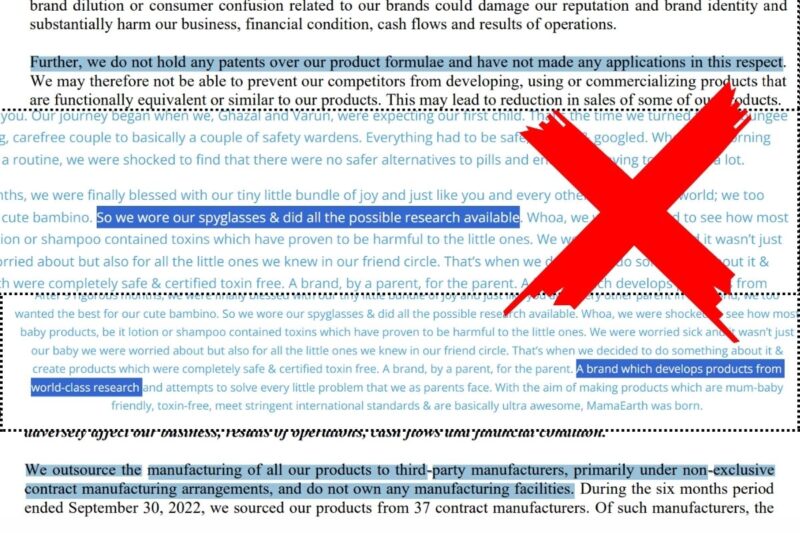Is Mamaearth IPO An Expected Mistake, Planned Intentionally For The Escape Of Early-Stage Investors?
Retail investors should proceed with caution when it comes to Mamaearth, as recent IPOs like as Paytm, Nykaa, Zomato, CarTrade, and PB Fintech, which targeted high valuations, have witnessed massive falls after stock market debuts. Furthermore, global stock market sentiment has been gloomy in recent weeks as a result of factors such as a spike in US bond yields, rising petroleum costs, and geopolitical issues.

The much-awaited Mamaearth-parent Honasa’s mcap is down INR 620 crore in pair of days since listing. The company’s mcap has fallen from INR 10,559 crore to INR 9,939 crore in the last week. The BPC firm’s share prices have fallen from on Friday (November 10) as it cracked over 15 per cent to touch its fresh all-time low in early trade on BSE. Honasa Consumer share price opened at ₹291.50 against the previous close of ₹302.15 and fell 15.24 per cent to its fresh all-time low of ₹256.10. Around 9:45 am, the stock was down 12.38 per cent at ₹264.75.
But is it a new or surprising event? I guess NO. How do you evaluate an IPO that declares in its red herring prospectus that it is raising funds to advertise and raise awareness about its products? Most of us would be sceptical because IPOs are often used to fund long-term capital expenditures or to meet working capital requirements. Honasa Consumer, on the other hand, intends to set aside INR182 crore from the IPO proceeds for advertising reasons.
How the beauty of Mamaearth is becoming a beast for investors?
As the startup ecosystem flooded the market in the just post-pandemic era and the slogan of entrepreneurship all over the nation circulated, people started believing that these new companies, aka the startups, were focussing deeply on their modern problems, finding realistic solutions and hence innovating their lives. However, everything that goes up will eventually come down. So, the same happened with these new-age startups. They bloomed like anything, but then there occurred the disclosures of poor business models and lack of financial regularities, and the top of the cherry was the overpriced valuations.
Investors get fooled by the listings of Paytm, and now they are more concerned about infusing their funds in any new-age businesses like Mamaearth. In the same run, Mamaearth was under vigilance by investors, and it seems that people now are a bit more careful before investing. Investors remain cautious about Mamaearth due to the loss-making nature of the business, high portion of OFS, strong rivalry with margin pressure, low promoter stake, and weak financials, all of which suggest a cautious stance, as historical listings with high valuations have frequently faced post-listing challenges.

Are the financials of Mamaearth weak?
Based on its annualised FY24 earnings per share, the Mamaearth IPO seems to be aggressively priced at 97 times, discounting any immediate favourable variables, and it appears that the company is exploiting its proven track record to justify a premium valuation. They emphasise that, in addition to its recent profitability, Honasa’s continued struggle to strengthen its bottom line and assure long-term earnings development necessitates caution. According to analysts, Honasa’s revenue dependence on Mamaearth is 82 per cent in FY23, which is worrying and high risk.
Honasa Consumer lost Rs 151 crore in FY23, compared to a profit of Rs 14.44 crore in FY22. It reported a net loss of Rs 1,332.21 crore at the end of FY21. According to the most recently published financials, it claimed a net profit of Rs 25 crore for the three months ended June. Its income increased at an 80 per cent CAGR from FY21 to FY23, while volume increased at a 102.28 per cent CAGR.
It has an adjusted Ebidta of 3.4 per cent as of FY23, with negative working capital due to its asset-light model. In the long run, negative working capital is likely to be an issue. Negative working capital occurs when the current liabilities surpass the current assets. If a company’s current liabilities are constantly more than its current assets, its liquidity ratios may be unprofitable.
The major flagship brand is on shaking grounds.
The majority of us never knew it is Honasa Consumer Ltd, but always learnt about Mamaearth. This is the importance of this one brand for the famous ‘House of Brands’. A major portion or major revenue for Honasa Consumer comes from its flagship name ‘Mamaearth’. However, due to the company’s defocus on the D2C platform for growth, Mamaearth’s brand sales in the D2C channel decreased in Q1FY24 (revenue contribution in online sales decreased to 36 per cent in Q1FY24 compared to 47 per cent in Q1FY22).
The D2C platform’s revenue from existing customers increased by 63 per cent, while any delay in new-customer recruiting will have a detrimental impact on its growth ambitions. This is something that the investors are worried about.
Betting with big traditional players is not that easy.
There are no listed firms in India or around the world of comparable size in the same industry as Honasa. As a result, Honasa has not supplied an industry comparison to itself. However, there are larger listed firms in India that engage in the FMCG industry, including the BPC segment, with longer operating histories and diverse business structures and offers. Honasa sees only a few listed companies as competitors for their BPC products.
Hindustan Unilever, Colgate Palmolive India, Procter & Gamble Health & Hygiene, Dabur India, Marico, Godrej Consumer Products, Emami, Bajaj Consumer Care, and Gillette India are among these companies. However, it is not that easy to compete with these businesses on offline channels as they have a strong base there. Mamaearth will have to spend huge on generating its offline presence competitive with traditional players, which could deplete the margin.
Doing the same mistake again?
The company has established a portfolio of inorganic brands, with effective scale-up being critical. Given the lack of visibility on profitability, the company has been forced to scale down Momspresso‘s platform. To that end, the company has reported a goodwill impairment loss of Rs 136 crore.
When you dig deeper, you will learn that the platform Momspresso does nothing, nor sells products, etc.; it was just a content platform that was used by Honasa for advertising their brand. after incurring such a huge loss in advertising, Honasa has said in its DRHP that the returns of the IPO will be used for advertising. It seems that the company hasn’t learnt anything from its previous experience and is again making the same mistake. According to research, just approximately a third of all marketing campaigns have a substantial immediate influence on sales, and less than a quarter have any long-term effect.
Advertising can be required at the initial level, but once the brand is established, Mamaearth need to focus on R&D so that it can survive in the market. This is something again investors are concerned about.
Not being interested in having Intellectual Property Rights can be a deadly sign for Mamaearth.
Globally, there is a growing demand among consumers for ‘made for them’ goods that are tailored to specific skin or body types. They are more willing to pay a premium for effective and safe solutions, which has resulted in strong growth in the masstige and premium categories. In such a circumstance, the lack of a patent or, at the very least, the absence of exclusive contracts might cause obstacles for the company, making the path for retail investors to invest in this company even more difficult.

Conclusion.
One of Mamaearth’s primary dangers is a lack of financial performance. In the past, the company’s operating, investing, and financing operations resulted in negative cash flows. “It has previously suffered losses.” Any future losses may have a negative impact on their business and the value of their equity shares. Subsidiaries such as Just4Kids (Momspresso), BBlunt, B:Blunt Spratt, and Fusion have suffered losses in the past. There is no guarantee that these businesses will remain lucrative in the future.
The majority of the capital raised can be attributed to OFS, where the promoters and current investors are aiming to maximise their investments. The promoters (Varun Alagh and Ghazal Alagh) are the top-selling stockholders in the OFS category, followed by Sofina Ventures SA, Evolvence India, Fireside Ventures, Stellaris, Kunal Bahl and Rohit Kumar Bansal (of Snapdeal), Rishabh Mariwala (of Sharrp Ventures), and actor Shilpa Shetty Kundra.
It seems that the IPO was intentionally planned to give an advantageous exit to early-stage investors on the pretext of looting the retail investors, especially when the company has nothing special in their portfolio: no proof of specific formulation to justify the punchline of ‘toxin-free’ products, no patent to survive in the market, no in-house manufacturing facilities and many more. Just playing on the emotions of the parent-child bond is not going to help Mamaerath to stay longer in the market, at least on profitable grounds, that can give retail investors hope to infuse their funds into the company.





